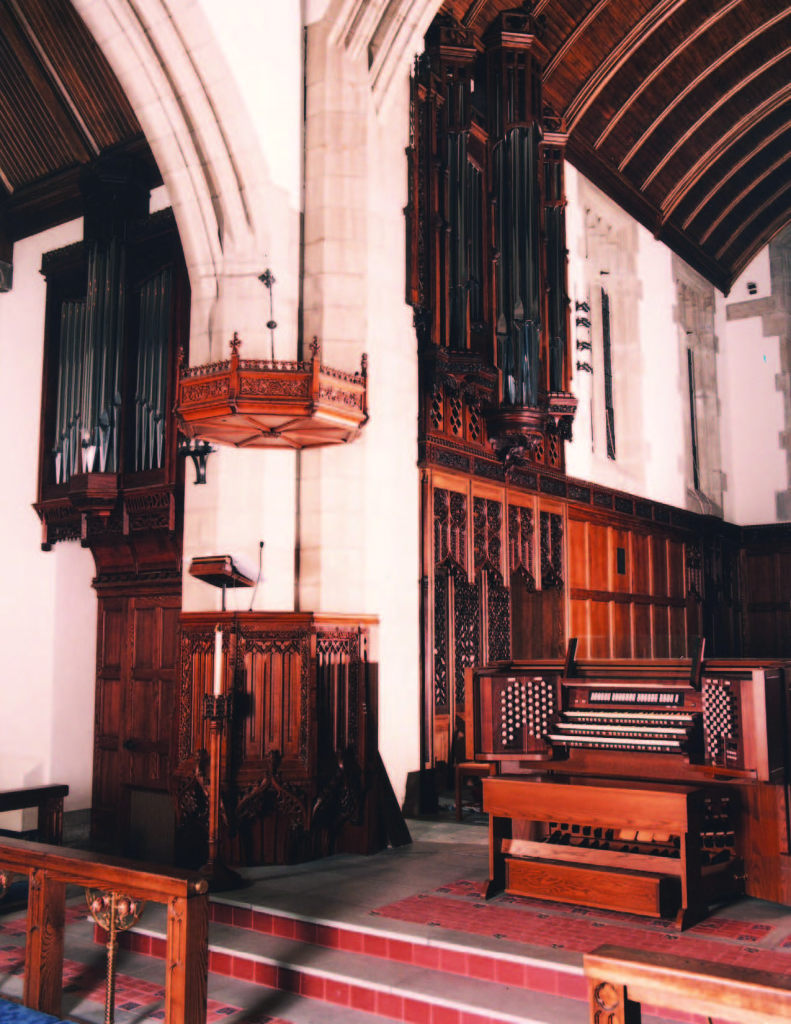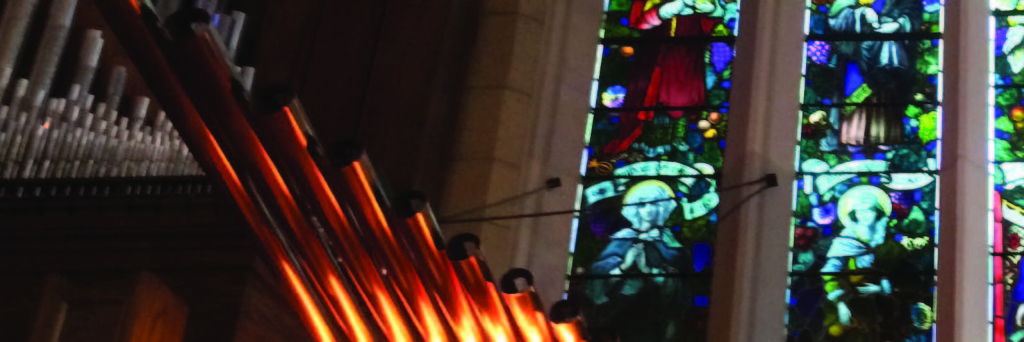The History of the Organs of Saint John’s, West Hartford, CT
Written in 1996, and revised 2010 by Ralph Valentine. Editing and additional information by William Uricchio, December, 2010; and by Scott Lamlein, 2015. Click here for printed brochure.
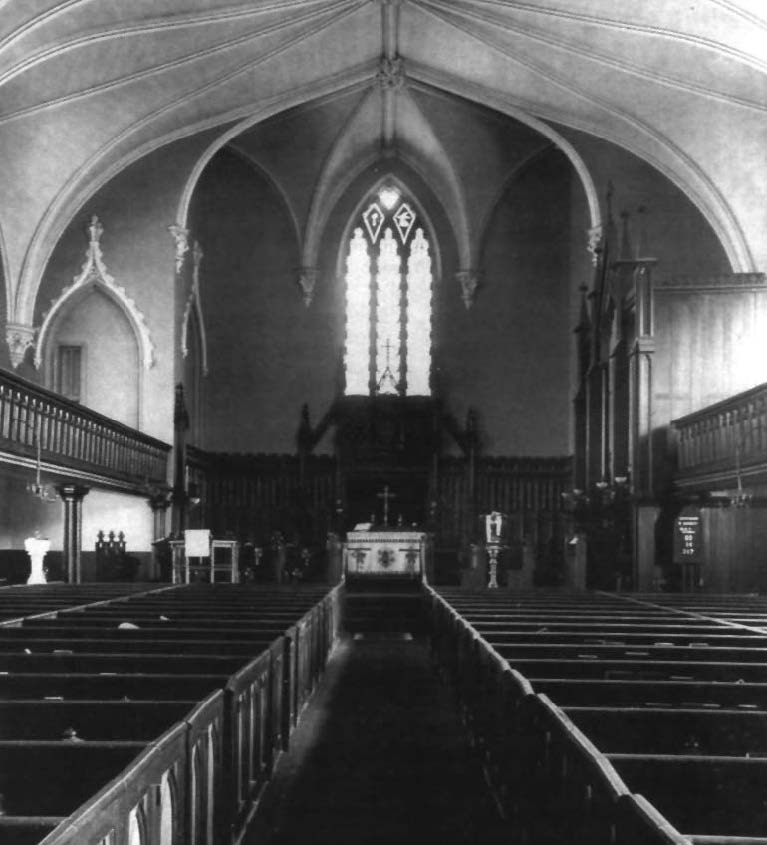 The first organ for the original St. John’s Church on Main Street in Hartford was built in 1841 by E. & G. G. Hook of Boston. In keeping with a popular practice of the time, this instrument was placed in an organ/choir loft over the narthex at the back of the church. The organ, Hook’s Opus 47, consisting of two manuals and twenty-two stops, was described by the Hartford Courant in 1842 as having “superior finish, tone and compass, with a Gothic exterior.”
The first organ for the original St. John’s Church on Main Street in Hartford was built in 1841 by E. & G. G. Hook of Boston. In keeping with a popular practice of the time, this instrument was placed in an organ/choir loft over the narthex at the back of the church. The organ, Hook’s Opus 47, consisting of two manuals and twenty-two stops, was described by the Hartford Courant in 1842 as having “superior finish, tone and compass, with a Gothic exterior.”
During the church’s more than sixty years in Hartford, its organs were moved a number of times, both to improve the church’s layout, which seems to have been an ongoing issue, and the sound of the instrument. The first move, which happened before 1861, brought the organ down from the loft to the main floor of the church, possibly in conjunction with a tonal improvement to the instrument in the 1850s.
In 1861, the purchase of a new organ, Hook’s Opus 295 of two manuals and thirty stops, provided an opportunity to move the instrument back to where some felt it gave better service. The Courant editorialized in May of 1862 that “we are glad to hear that the organ…is to be removed from its present location under the gallery to the former organ loft. It is too cramped now to be heard well or to advantage, besides we believe that the tone of the instrument is being impaired. The choir will also have a better chance of rendering the fine music for which this church is celebrated.”
In November, 1862, the Courant noted that “a very handsome black walnut case, in the Gothic style, has been erected” for the new instrument which was first used for Christmas Eve services.
Although the Hartford St. John’s was a large building with over 800 seats, a third organ move, in 1890, was necessitated by space issues resulting from the activist congregation’s many programs. The following year, the Courant stated that the instrument had been “removed to the body of the church” and “the old tower room and the organ loft choir alley…have been converted into a parish room…[while] the south staircase to the old organ gallery has been closed and a comfortable pastor’s study gained.”
A final “adjustment” occurred near the end of the nineteenth century when the organ was brought from one side of the church to the other to make space for a vestry room. The main floor placement is shown in the photograph above, where the organ case can be seen at the right (south) side of the sanctuary.
St. John’s, West Hartford, to 1992
When J. Pierpont Morgan and the trustees of the Wadsworth Atheneum offered to buy the old, deteriorating church in order to use the land for a splendid new art museum extension, parishioners decided that the time had come for St. John’s to relocate to West Hartford.
A magnificent new building, designed by Bertram Goodhue, of the renowned firm of Cram, Goodhue & Ferguson, was completed in 1909.
The Austin Organ Company of Hartford was chosen to build a two manual tubular pneumatic instrument of fourteen ranks, eight of which were retained from the 1861 Hook organ in the original edifice. Both Hook instruments in the Hartford church had been financed by subscription but the first West Hartford organ was the memorial gift of two brothers, John O. Enders and Dr. Thomas B. Enders.
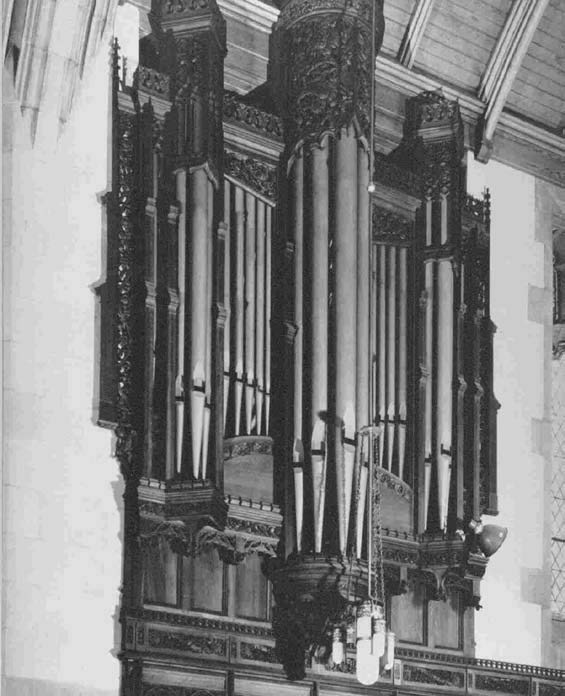
The new 1909 organ, Austin’s Opus 231, (shown here) was installed in the present chamber in the left side of the chancel at a cost of $3,850. The organ cases were handsome in appearance and contained several speaking pipes. The large scaled sixteen foot Open Wood pipes were attached to the sloped ceiling of the chamber as they are in the current installation.
The organ continued to give reliable service for many years when, in 1945, the builders supplied a new console, swell shade engine, fan tremolo and generator, and electrified the original tubular stop action.
In 1949, Austin Organs was once again chosen to build a completely new instrument. Opus 2123, with three manuals and 37 ranks, was generously underwritten as a memorial to the founder and past-president of The Austin Organ Company, John T. Austin, by members of his family who were parishioners of St. John’s Church. It was dedicated in September, 1950, by Dr. Robert Baker.
A newly fabricated chamber on the right side of the chancel provided space for the Swell division which was concealed by a facade of non-speaking pipes trimmed with gold paint.
Thanks to the generosity of Mr. and Mrs. Henry G. Robinson, Jr., a nine rank Antiphonal Organ, including horizontally mounted trumpets, was installed on the rear wall above the narthex in 1978.
Chancel & Antiphonal Organs, 1992 –
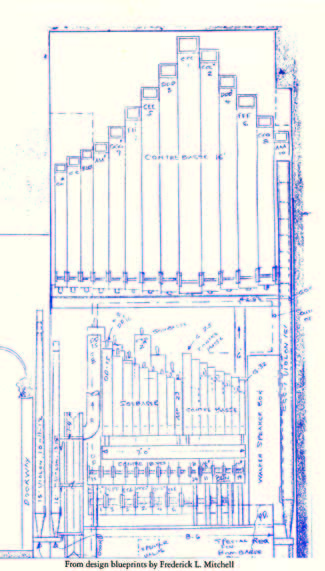 The venerable Austin performed faithfully for over forty years without any major repairs until the night of Saturday, October 10, 1992, when a devastating fire caused considerable damage to much of the building and organ.
The venerable Austin performed faithfully for over forty years without any major repairs until the night of Saturday, October 10, 1992, when a devastating fire caused considerable damage to much of the building and organ.
The fire destroyed a significant portion of the beautifully carved main case in the chancel and spread to the large scale 16 foot Open Wood pipes which were fastened to the ceiling of the Great Organ chamber. The roof collapsed on the Swell Organ division on the right side of the chancel, crushing many of the pipes. The majority of the pipes of the Antiphonal Organ melted from the intense heat caused by the fire, and the console, which was located in the sacristy (current vesting room), suffered extensive smoke and water damage.
In spite of the considerable water and fire damage, a decision was made to try and use as much of the former instrument as possible in designing and constructing its replacement, Austin Opus 2761. As a result, approximately 38% of the pipework in the new instrument was recycled from the 1950 Austin and three of the original windchests were also reused. Thanks to a generous gift by the family of Mr. and Mrs. Henry G. Robinson, Jr., a number of tonal improvements became possible. As constructed, the instrument contained a total of 51 stops, 64 ranks, and 3,721 pipes.
In drawing up the plans, shown above, for the new organ, every effort was made to address the weaknesses and shortcomings of its predecessor. The first step was to remove a massive stone arch in the main chamber which formerly had blocked the tonal egress of approximately 60% of the Great, Choir, and Pedal pipes and replace it by a simple, thin I-beam which could support the new Grand Orgue windchest and make a significant improvement in the sound of the instrument.
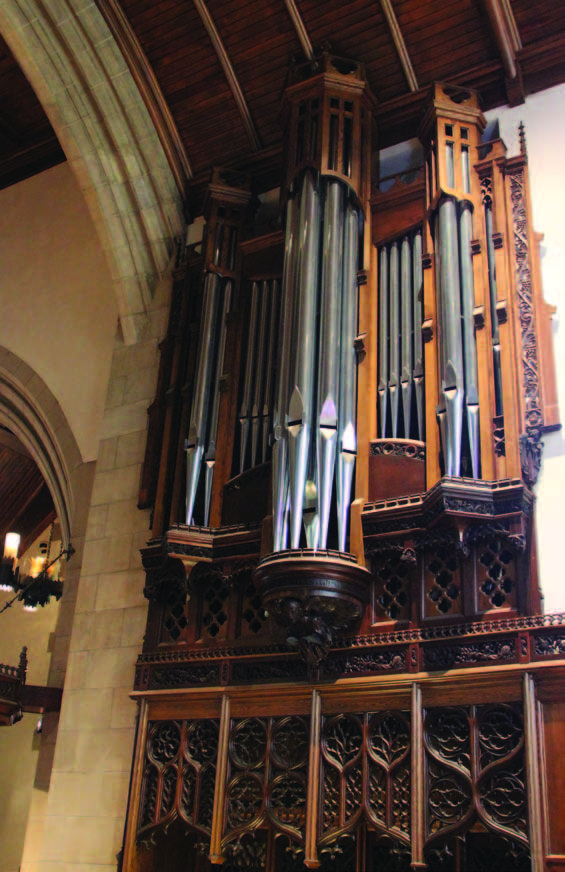 The Choir Organ, which formerly was situated behind and below the Great Organ, was relocated to the right side of the chancel in a new chamber constructed beside the Swell Organ where its contribution to the total ensemble was dramatically increased. Tuning and maintenance of the entire organ has been facilitated by having all the pipes of each separate division at the same approximate level above the chancel floor.
The Choir Organ, which formerly was situated behind and below the Great Organ, was relocated to the right side of the chancel in a new chamber constructed beside the Swell Organ where its contribution to the total ensemble was dramatically increased. Tuning and maintenance of the entire organ has been facilitated by having all the pipes of each separate division at the same approximate level above the chancel floor.
Many tonal additions were made to the Pedal Organ, which was sadly inadequate in the 1950 design, having contained only 56 pipes of its own (out of a total of nearly 3,000).
Just as the Hartford church’s organs had moved to and fro through the years, the West Hartford consoles were relocated more than once, usually in an effort to either make space for an expanding number of choristers or to improve sight lines.
The first console was placed at the right side of the chancel near the altar but, by the time of the fire, the 1950 edition had been removed to the sacristy behind the choir stalls and clergy seating. In this location, the organist, sitting on a platform and aided by a mirror, hand signals from the choir, and eventually a closed circuit television, was required to peer into the sanctuary through an opening in the grille work in order determine the timing of the service and to direct the choir.
Placed in the chancel area, the new three-manual drawknob console for Opus 2761 has allowed the organist to judge the balance between the sound of the organ, choirs, and congregation much more accurately than the previous sacristy installation. The console was equipped with solid state combination action with 25 memory levels and is fully MIDI compatible which allows for maximum flexibility in utilizing the many sound possibilities of the instrument. Subsequently, the console computer has been upgraded twice, most recently in 2020, to add piston sequencer functionality and increase the memory levels to 250 – all to accommodate the constant use of the instrument by regular and visiting organists.
The 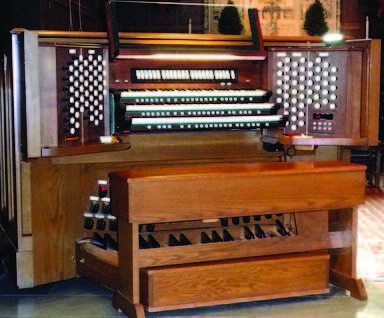 main case on the east side of the chancel, with reconstructed and refurbished woodwork, is shown above. Two new cases on the west side of the chancel handsomely reflect the restored original. All the cases, including one in the east transept, now contain
main case on the east side of the chancel, with reconstructed and refurbished woodwork, is shown above. Two new cases on the west side of the chancel handsomely reflect the restored original. All the cases, including one in the east transept, now contain 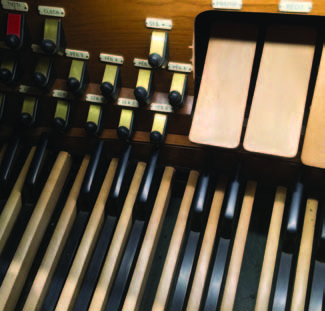 speaking pipes of polished zinc from the 8’ Montre, Violon, and Flûte Harmonique of the Grand Orgue as well as the 8’ Octave Basse of the Pédale.
speaking pipes of polished zinc from the 8’ Montre, Violon, and Flûte Harmonique of the Grand Orgue as well as the 8’ Octave Basse of the Pédale.
Additional attractive panelling was constructed for the chests of the Antiphonal Organ which remained basically similar to its original 1978 design except that it was subsequently winded from the main blower.
Finally, the main blower motor, which had been recycled from an earlier instrument, was replaced in 2008 with a quieter and more efficient model.
Transept Console
After the present main instrument was completed, the music program expanded considerably with the addition of many new members to the Adult and Youth Choirs.
On most Sundays, the narrow chancel at St. John’s could not accommodate all the singers and one of the choirs would often be relegated to the east transept for the duration of the service. Members of the Youth Choir (now Choir School) would sing their anthems from the steps of the chancel in order to optimize their sound projection. Unfortunately, the organist, seated up in the chancel, would not be able to see the Youth Choir director and judge the balance of the organ accompaniment accurately.
A decision was made to purchase a small, two manual Rodgers organ console for the east transept, which could be used to control the stops of the main organ as well as the opening and closing of the expression shades of the Positif and Recit. The Rodgers console, installed in 2001, also made it possible to perform large-scale works that involve instruments as well as singers.
Chapel Organ
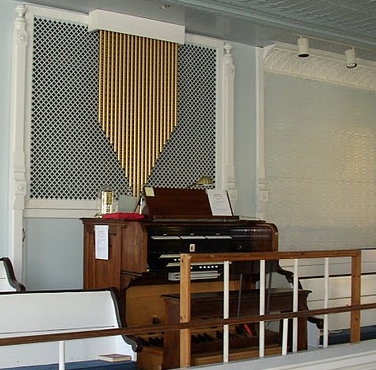 In 1955, a 250 seat chapel was constructed to accommodate the large church Sunday School program. At that time, members of the Austin family donated a seven rank unit organ, Opus 2237, to provide music. Developed in collaboration with then organist Clarence Watters, this “5-7” unit organ was a prototype instrument which went on to be a best-selling stock instrument for Austin. Following the 1992 fire, St. John’s held services at a number of nearby locations and eventually reoccupied the chapel as the reconstruction of the main building proceeded. Opus 2237 performed splendidly until an eventual redesign of the chapel space into an education wing led to its purchase by Connecticut’s Bridgewater Congregational Church.
In 1955, a 250 seat chapel was constructed to accommodate the large church Sunday School program. At that time, members of the Austin family donated a seven rank unit organ, Opus 2237, to provide music. Developed in collaboration with then organist Clarence Watters, this “5-7” unit organ was a prototype instrument which went on to be a best-selling stock instrument for Austin. Following the 1992 fire, St. John’s held services at a number of nearby locations and eventually reoccupied the chapel as the reconstruction of the main building proceeded. Opus 2237 performed splendidly until an eventual redesign of the chapel space into an education wing led to its purchase by Connecticut’s Bridgewater Congregational Church.
As an interesting coda to the history of St. John’s many organs, the former chapel organ, like the first St. John’s organ in Hartford, is positioned in a loft over the entrance at the rear of the church’s sanctuary.
The St. John’s Organ in Concert
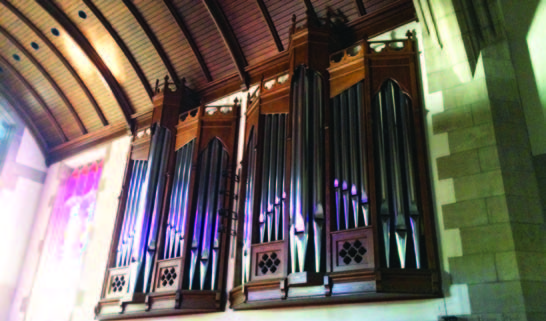 Since its installation in 1995, the Saint John’s organ has been featured in concert often, providing opportunities to educate the greater community on the beauty and triumph of organ music. The instrument is as exciting with Early Music and the music of J.S. Bach as it is with French Romantic music and music written in our time.
Since its installation in 1995, the Saint John’s organ has been featured in concert often, providing opportunities to educate the greater community on the beauty and triumph of organ music. The instrument is as exciting with Early Music and the music of J.S. Bach as it is with French Romantic music and music written in our time.
The 1996 inaugural season garnered much publicity, including a cover feature in The American Organist magazine. That year saw full-house concerts by international luminaries of the organ world and local favorites: John Scott (then of St. Paul’s Cathedral, London), Wilma Jensen (Nashville, TN), Ben Schaffer (West Hartford), Marilyn Keiser (Indiana University), Thomas Murray (Yale University), Ralph Valentine (then Organist and Choirmaster at St. John’s), and John Rose (Trinity College, Hartford).
It has been featured in two conventions of the American Guild of Organists, several “Pipescreams!” Halloween recitals, and in the 1996 “World’s Largest Organ Recital” – an event to raise awareness of the organ world-wide. Countless recitals have been presented by the resident musicians of St. John’s: Ralph Valentine (1976-2010), Peter Stoltzfus Berton (2010-2014), and Scott Lamlein (2014-present).
Through the years, the acclaimed St. John’s organs have drawn superb organists to the church, been used for a large number of concerts, and served as examples of the organ makers art by their builders. Two notable examples of recordings are an audio CD by performer Frederick Hohman playing the current instrument and a very unusual “concert” by a famous Canadian organist, Lynnwood Farnam, featuring the penultimate organ. For more information about these recordings, including audio links, please visit Organ Recordings.
The 2015-2016 twentieth anniversary season of St. John’s Music at the Red Door concert series celebrated this landmark instrument with a variety of performances and worship services: Charlotte Beers Plank, organist (former student of Ralph Valentine); Festival of Nine Lessons and Carols, featuring the St. John’s Youth and Adult Choirs (Scott Lamlein, director; Floyd Higgins, guest organist); Silent Film featuring Jason Roberts, organist; Bach’s “Art of Fugue” with SYREN Modern Dance (Rick Ericksen, organist); and Rutter’s “Requiem” featuring the St. John’s Youth and Adult Choirs (Scott Lamlein, director; Ralph Valentine, guest organist). The 25th anniversary season in 2021 featured a fine recital by New York organist David Hurd.
Perhaps unlike any other single musical instrument, the pipe organ has the power to express the full range of human and musical emotion, from the thunderous full ensemble to the most delicate whisper. The St. John’s organ serves to help praise God and carry out the mission of spreading peace and joy through music, week in and week out. It is a gift to us and our community, created to the glory of God.
St. John’s Episcopal Church
West Hartford, Connecticut
Austin Organs, Inc. Opus 2761
* Stops marked with an asterisk include revoiced pipes from the former instrument, Austin Opus 2123, including the Antiphonal Organ added in 1978. All pipes are of metal except for the following ranks which contain wood pipes: Récit 16′ Bourdon Doux, Positif 8′ Flûte Bouchée, Antiphonale 8′ Bourdon en Bois, and Pédale 16′ Contre Basse, 16′ Soubasse, 16′
Organ Specifications
GRAND ORGUE – at chancel left – 4 1/2″ wind
| Pitch | pipes | ||
| * | 16′ | VIOLON (15-24 new in transept case) | 61 |
| 8′ | MONTRE (1-24 in left chancel case) | 61 | |
| * | 8′ | VIOLON (extension of 16′ Violon) | 12 |
| 8′ | FLÛTE HARMONIQUE (1-12 in right rear Chancel case) | 61 | |
| 8′ | BOURDON | 61 | |
| * | 8′ | COR DE CHAMOIS | 61 |
| 4′ | PRESTANT | 61 | |
| 4′ | FLÛTE OUVERTE | 61 | |
| * | 2 2/3′ | QUINTE | 61 |
| * | 2′ | DOUBLETTE | 61 |
| 1 3/5′ | TIERCE (begins at tenor C) | 49 | |
| 1 1/3′ | FOURNITURE IV (19-22-26-29) | 244 | |
| 8′ | BOMBARDE (extension from Pédale – 7″ wind) | 29 | |
| 8′ | TROMPETTE EN CHAMADE (Antiphonale – 3 1/2″ wind) | 74 | |
| CLOCHES (electronic) | |||
| MIDI I, II, III |
POSITIF (expressive) – at chancel right front – 3 1/2″ wind
| * | 8′ | PRINCIPAL | 61 |
| 8′ | FLÛTE BOUCHÉE | 61 | |
| * | 8′ | FLÛTE DOUCE | 61 |
| * | 8′ | FLÛTE CÉLESTE (begins at tenor C) | 49 |
| 4′ | OCTAVE | 61 | |
| * | 4′ | FLÛTE À FUSEAU | 61 |
| * | 2 2/3′ | NASARD | 61 |
| 2′ | DOUBLETTE | 61 | |
| * | 2′ | QUARTE DE NASARD | 61 |
| * | 1 3/5′ | TIERCE | 61 |
| 1′ | SIFFLET (extension of 2′ Quarte de Nasard – prepared) | ||
| 2/3′ | CYMBALE IV (26-29-33-36) | 244 | |
| * | 8′ | CROMORNE | 61 |
| TREMBLANT | |||
| 8′ | TROMPETTE HARMONIQUE (15″ wind) | 61 | |
| 8′ | TROMPETTE EN CHAMADE (Antiphonale) | ||
| CLOCHETTES (8 bells) | |||
| MIDI I, II, III |
RÉCIT (expressive) – at chancel right rear – 5″ wind
| * | 16′ | BOURDON DOUX (extension of 8′ Flûte à Cheminée) | 12 |
| * | 8′ | PRINCIPAL | 61 |
| 8′ | FLÛTE À CHEMINÉE | 61 | |
| 8′ | VIOLE DE GAMBE | 61 | |
| * | 8′ | VOIX CÉLESTE (begins at tenor C) | 49 |
| * | 4′ | OCTAVE | 61 |
| * | 4′ | FLÛTE OCTAVIANTE | 61 |
| 2′ | OCTAVIN | 61 | |
| * | 2′ | PICCOLO HARMONIQUE | 61 |
| 1 1/3′ | LARIGOT | 61 | |
| 2′ | PLEIN JEU IV (15-19-22-26) (Draws 2′ Octavin) | 183 | |
| * | 16′ | BASSON (1-12 new) | 61 |
| * | 8′ | TROMPETTE | 61 |
| * | 8′ | HAUTBOIS (extension of 16′ Basson) | 12 |
| * | 4′ | CLAIRON | 61 |
| * | 8′ | VOIX HUMAINE (In separate enclosure – 4″ wind) | 61 |
| VOIX HUMAINE TREMBLANT | |||
| TREMBLANT | |||
| 8′ | TROMPETTE EN CHAMADE (Antiphonale) | ||
| MIDI I, II, III |
ANTIPHONALE – on rear wall of nave – 2 1/2″ wind
| 8′ | MONTRE | 61 | |
| * | 8′ | BOURDON EN BOIS | 61 |
| 4′ | PRESTANT | 61 | |
| 2′ | FLÛTE À BEC | 61 | |
| 2′ | FOURNITURE IV (l 5-19-22-26) | 244 |
PÉDALE – primarily at chancel left – 4 1/2″ wind
| 32′ | FLÛTE OUVERTE (electronic – 12 note ext of 16′ Contre Basse) | ||
| 32′ | CONTRE BOURDON (electronic – 12 note ext of 16′ Soubasse) | ||
| * | 16′ | CONTRE BASSE | 32 |
| 16′ | SOUBASSE | 32 | |
| * | 16′ | VIOLON (Grand Orgue) | |
| * | 16′ | BOURDON ANT (extension of Antiphonale 8′ Bourdon en Bois) | 12 |
| * | 16′ | BOURDON DOUX (Récit) | |
| * | 10 2/3′ | QUINTE (from Récit 16′ Bourdon Doux) | |
| 8′ | OCTAVE BASSE (1-17 in right front chancel case) | 32 | |
| 8′ | FLÛTE COUVERTE (extension of 16′ Soubasse) | 12 | |
| 8′ | FLÛTE À CHEMINÉE (Récit) | ||
| * | 8′ | COR DE CHAMOIS (Grand Orgue) | |
| * | 4′ | BASSE DE CHORALE | 32 |
| 4′ | COR DE NUIT | 32 | |
| 2′ | FOURNITURE III (22-26-29) | 96 | |
| 32′ | CONTRE BOMBARDE (electronic – 12 note ext of 16′ Bombarde) | ||
| 16′ | BOMBARDE (7″ wind) | 32 | |
| * | 16′ | BASSON (Récit) | |
| 8′ | BOMBARDE (extension of 16′ Bombarde) | 12 | |
| 8′ | TROMPETTE EN CHAMADE (Antiphonale) | ||
| * | 8′ | TROMPETTE (Récit) | |
| * | 4′ | CROMORNE (Positif) | |
| MIDI I, II, III |
COUPLERS
Récit à Pédale 8, 4
Positif à Pédale 8, 4
Grand Orgue à Pédale 8, 4
Grand Orgue Unisson Muet
Grand Orgue à Grand Orgue 16, 4
Récit à Grand Orgue 16, 8, 4
Positif à Grand Orgue 16, 8, 4
Antiphonal sur Grand Orgue
Positif Unisson Muet
Positif Muet (except Trompette Harmonique and Trompette en Chamade)
Positif à Positif 16, 4
Récit à Positif 16, 8, 4
Grand Orgue à Positif
Pédale à Positif
Antiphonal sur Positif
Récit Unisson Muet
Récit à Récit 16, 4
Positif à Récit 16, 8, 4
Antiphonale sur Récit
Grand Orgue – Positif Exchange
ACCESSORIES
Artisan Solid State Combination Action with 250 memory levels
Balanced expression pedals – Récit and Positif
Programmable Crescendo pedal
15 Adjustable General combinations (thumb and toe)
8 combinations for each of the following:
Grand Orgue (thumb) Récit (thumb), Positif (thumb), Pédale (toe)
3 combinations for Antiphonale (thumb)
4 combinations for Couplers (thumb)
Reversibles for unison couplers, Clochette, 32′ stops
2 Tuttis
Melody coupler
Bass coupler
Pedal Divide
Transposer
Registration Sequencer
Memory Lock
Integrated Record/Playback system
Adjustable Bench
Console is on a moveable dolly and can be centered in the chancel for recitals.
Tonal Design: David A.J. Broome and Ralph B. Valentine
Layout: Frederick L. Mitchell
Installation: Jon van Houten
Tonal Finishing: Daniel Kingman, assisted by David Johnston and Christopher Broome
Case Design: Charles Nazarian
Case Construction: Matthew Burke of Kingsland Co., Norfolk, CT
Acoustical Consultant: Larry King
Organ Consultant: Ralph B. Valentine
